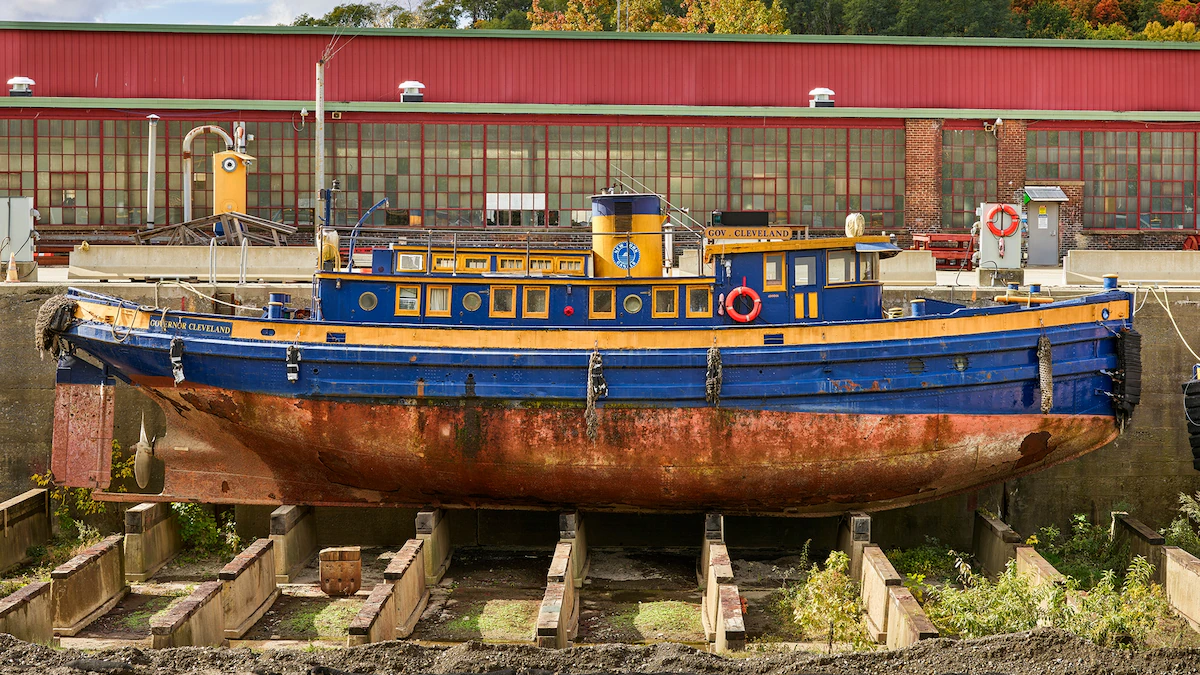
The Erie Canal is largely quiet now, but when the Seneca Chief set sail for Manhattan from Buffalo, New York, on September 24, 1825, this inaugural voyage heralded a century-long revenue stream. Marking the waterway’s official opening, the Erie Canal became America’s first superhighway, just on water.
The Seneca Chief sails again
Two hundred years to the day, during the Buffalo-hosted 2025 World Canals Conference, a newly built replica of the Seneca Chief will retrace that historic voyage, stopping at 28 canal sites along the way. The boat will arrive in New York City on October 26, marking the bicentennial of the opening of the Erie Canal.
Now officially named the Erie Canal Boat Seneca Chief, the 73-foot, 40-ton boat will launch from Buffalo’s Canalside waterfront, where she was built in the Buffalo Maritime Center’s Longshed. The work began in October 2020 and involved hundreds of volunteers and several boat builders.
Constructing the canal
Construction on the canal began in 1817. While it changed over the decades, in 1825 the canal started where Lake Erie flows into the Niagara River at Buffalo and ended 363 miles later at the mighty Hudson River in Albany. The canal was built exclusively by human and animal labor, hand tools, and dynamite.
“It was an amazing technological feat without anyone really knowing anything about how to do it,” says John Montague, founder and president emeritus of the Buffalo Maritime Center. “They had primitive instruments and had to make the canal go over high land and low land.”
The biggest feat was in navigating the Niagara escarpment, which stretches between Lake Ontario and Lake Erie and has a 120-foot drop in elevation at its deepest. Surveyors found a stretch of land with a drop of only 60 feet about 29 miles northwest of Buffalo, where three log cabins stood in the beautiful wilderness. Here, Nathan S. Roberts—an Upstate math teacher working as a surveyor for the canal’s master engineer Benjamin Wright—designed the revolutionary Flight of Five locks.
“Never before had five locks in succession been built anywhere in the world,” says David Kinyon, chairman of Lockport Locks Heritage District. “To have five in succession was amazing, but Roberts built a double set of five locks: one for eastern traffic, one for westbound, which negated congestion.”
The Buffalo boost
The Erie Canal boosted the economic ascendancy of New York State, also empowering canal cities such as Albany, Utica, Syracuse, and Rochester. Buffalo transformed from a village into a major inland port, and became the state’s second largest city after New York City, lined with Victorian mansions and interconnected parks designed by Central Park architect Frederick Law Olmsted.
“The impact the canal had on national U.S. history can’t be overstated,” says Montague. “Without the canal, wealth going to New York would otherwise have gone south to New Orleans, giving the Civil War a different outcome.”
(These trails aren’t for hikers, they’re for kayakers)
Damage caused by the canal
A whole society grew up on the canal: Families lived on barges tended by barges selling food, clothing, and everyday items.
Not everyone was happy about the change from wilderness with wildness, however. “The realties of the canal and creating 360-mile waterfront with all the problems of lawlessness, prostitution, and crime that comes with a transient population brought social conflict,” says Montague. “The normal status quo was shaken up.”
Few took notice, or cared, that Native American Haudenosaunee had been displaced by the canal. “The canal accelerated it, but the federal and state governments planned the Haudenosaunee’s removal much earlier,” says Melissa Parker Leonard, a Buffalo-raised Tonawanda Seneca descendant.
“The canal was the impetus,” she adds. Leonard spoke at Canalside this summer about the forced removal of Native Americans in New York to the Midwest. And of their resilience: “We assimilated,” she says. “We didn’t all leave.”
The canal also crippled ancient ecosystems on land and water, something the Seneca Chief crew will recognize by planting 28 native white pine trees, a Haudenosaunee symbol of peace and prosperity. The trees will be planted in 28 towns along the route—hardly accounting for the thousands felled for the canal.
“The canal really screwed up the environment,” says Montague. “There was an aggressive approach of man against wilderness and the engineers destroyed truly remarkable unbroken wilderness to lay out a flat canal.”
“Our project to tell the story is not just the glory and the good,” he adds. “It’s the good, the bad, and the ugly.”
What to see
Docked at Canalside, the Seneca Chief’s September sail to Manhattan is the bicentennial’s highlight. The immersive “Waterway of Change: Complex Legacies of the Erie Canal” exhibit in the Longshed and Explore Buffalo’s guided 90-minute Canalside tour gives great insight.
In Lockport, take the guided Flight of Five Lock Tenders tour and explore its lock museum. Experience the mighty drop from within the five-ton wood lock gates via Lockport Locks and Erie Canal Cruises. Many towns on the route have their own celebrations and visitors can sail, hike, or bike along the Erie Canal.
Where to eat and stay
Strong Hearts on Buffalo’s Niagara Street offers plant-based eating for all tastes: The well-stuffed sandwiches are a highlight. The Seneca Chief sails by Rochester, where Redd, owned by Michelin-starred chef Richard Reddington, a Rochester native, is undoubtedly one of the best restaurants in New York. In Buffalo’s Black Rock neighborhood, the Dapper Goose’s tailored modern American menu is served in its cozy dining room or on its quiet outdoor patio.



